United Tribes of New Zealand
The United Tribes of New Zealand (Māori: Te W(h)akaminenga o Nga Rangatiratanga o Nga Hapu o Nu Tireni) was a confederation of Māori tribes based in the north of the North Island.
United Tribes of New Zealand Te W(h)akaminenga o Nga Rangatiratanga o Nga Hapu o Nu Tireni | |||||||||
|---|---|---|---|---|---|---|---|---|---|
| 1835–1840 | |||||||||
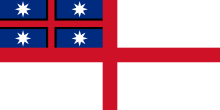  Flag | |||||||||
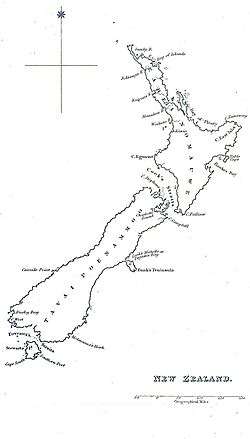 New Zealand in 1832 | |||||||||
| Status | Independent State | ||||||||
| Capital | Waitangi | ||||||||
| Common languages | Māori, English | ||||||||
| Government | Confederation | ||||||||
| Hereditary chiefs and heads of tribes | |||||||||
• 1835–1840 | Northern chiefs | ||||||||
| British Resident | |||||||||
• 1835–1840 | James Busby | ||||||||
| Legislature | Congress at Waitangi | ||||||||
| Historical era | Colonial period | ||||||||
| 1835 | |||||||||
| 1840 | |||||||||
• Colony of New Zealand | 1841 | ||||||||
| |||||||||
| Today part of | New Zealand | ||||||||
History
The confederation was convened in 1834 by British Resident James Busby. Busby had been sent to New Zealand in 1833 by the Colonial Office to serve as the official British Resident, and was anxious to set up a framework for trade between Māori and Europeans. The Māori chiefs of the northern part of the North Island agreed to meet with him in March 1834. Rumours began spreading that the Frenchman Baron Charles de Thierry planned to set up an independent state at Hokianga. The United Tribes declared their independence on 28 October 1835 with the signing of the Declaration of Independence.[1] In 1836, the British Crown under King William IV recognized the United Tribes and its flag. Busby's efforts were entirely too successful: as the islands settled down, the British began to consider an outright annexation.
By 1839, the Declaration of the United Tribes had 52 signatories from Northland and a few signatories from other parts, notably from the ariki of the Waikato Tainui, Pōtatau Te Wherowhero.[2] In February 1840, a number of chiefs of the United Tribes convened at Waitangi to sign the Treaty of Waitangi.[3] During the Musket Wars (1807 – 1842), Ngāpuhi and other tribes raided and occupied many parts of the North Island, but eventually reverted to their previous territorial status as other tribes acquired European weapons.
From a New Zealand standpoint under the settler government, the Confederation has been considered to have been assimilated into a new entity after the signing of the Treaty of Waitangi; the Declaration is viewed in large part as merely a historical document.[1] In recent times, questions have arisen regarding the constitutional relevance of the Declaration.[4]
New Zealand Company use of United Tribes flag
In 1840 the New Zealand Company raised the flag of the United Tribes at their settlement in Port Nicholson (Wellington),[5] proclaiming government by "colonial council" that claimed to derive its powers from authority granted by local chiefs. Interpreting the moves as "high treason," Governor William Hobson declared British sovereignty over the entirety of the North Island on 21 May 1840,[6] and on 23 May declared the council illegal.[7] He then despatched his Colonial Secretary, Willoughby Shortland, with 30 soldiers and six mounted police on 30 June 1840,[5] to Port Nicholson to tear down the flag. Shortland commanded the residents to withdraw from their "illegal association" and to submit to the representatives of the Crown.[8]
Modern developments
As of October 2010, the Waitangi Tribunal began investigating the claim by Ngāpuhi that their sovereignty was not ceded in their signing of the Treaty of Waitangi.[9] The Tribunal, in Te Paparahi o te Raki inquiry (Wai 1040)[10] is in the process of considering the Māori and Crown understandings of He Whakaputanga o te Rangatiratanga / The Declaration of Independence 1835 and Te Tiriti o Waitangi / the Treaty of Waitangi 1840.
Many of the arguments being used are outlined in Paul Moon's 2002 book Te Ara Ki Te Tiriti: The Path to the Treaty of Waitangi, which argued that not only did the Maori signatories have no intention of transferring sovereignty, but that at the time the British government and James Busby did not wish to acquire it and that the developments and justifications leading to the present state were later developments.[11] It is estimated that the hearings will last between four and six years, and may serve a serious precedent for all Maori tribal groups if the Tribunal recognizes Ngāpuhi sovereignty. A common Ngāpuhi interpretation of the Declaration of the United Tribes is that the British government was simply recognizing Māori independence and putting the world on check, merely re-asserting sovereignty that had existed from "time immemorial".[12], Update Nov 14, 2014.[13]
Flag
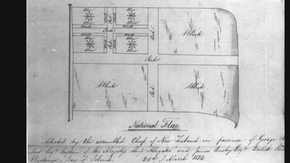
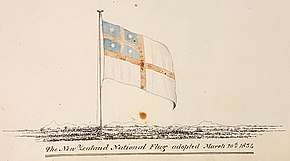
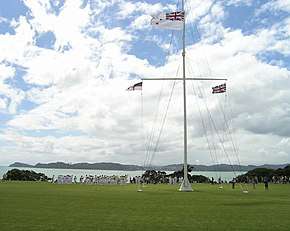
The idea of a flag to represent New Zealand first arose when the New Zealand-built trading ship Sir George Murray was seized in Sydney for sailing without a flag or register in 1830. British navigation laws applied in Australia and ruled that every ship must carry an official certificate that included the nationality of the ship. New Zealand was not yet a British colony, so could not sail under a British flag or register. With no flag to represent the islands, trading ships and their cargoes could be confiscated.[14] While a temporary licence was granted for the Sir George Murray by New South Wales authorities, it was clear that a more permanent solution was needed. Busby was approached by Maori chiefs in 1833 about the matter of a flag. Busby asked Reverend Williams and the Colonial Secretary Richard Bourke in New South Wales for assistance, and, with additional consultation with tribal leaders, three designs were drawn up.
On 20 March 1834, three designs were put to 25 northern Maori chiefs at Waitangi by James Busby and Captain Lambert of the man-of-war HMS Alligator. By a vote of 12-10-3, the design now widely known as the United Tribes Flag was chosen.[15] British, American, and French representatives witnessed the ceremony, which included a 13-gun salute from the Alligator.[16][17]
The flag was based in part on the St George's Cross that was already used by the Church Missionary Society, with a canton featuring a smaller red cross on a blue background fimbriated in black, and with a white eight-pointed star in each quarter of the canton.[18] When officially gazetted in New South Wales in August 1835, the description did not mention the fimbriation or the number of points on the stars.[19] The description was: "A red St. George's Cross on a white ground. In the first quarter, a red St. George's Cross on a blue ground, pierced with four white stars."[20] This version of the flag served as the de facto national flag of New Zealand from 1835 until the signing of the Treaty of Waitangi in February 1840,[21] although the United Tribes flag continued to be used as a New Zealand flag after the Treaty, for example the flag features on the medals presented to soldiers who served in the South African War (1899–1902).[22]
The version of the flag with black fimbriation and eight-pointed stars is widely used today as a flag by Māori groups throughout New Zealand, who also refer to it as the He Whakaputanga flag.
In July 2009 it was proposed as one of four possible designs for an official Māori flag at a series of hui around New Zealand. The flag is also occasionally encountered with black or white fimbriation and six-pointed stars.
As stated in E.M.C. Barraclough's book Flags of the World (ISBN 978-0723220152), The Shaw, Savill & Albion Line used this flag (though with white fimbriation instead of black and a proportions change from 1:2 to 3:5) as its company flag during its existence from 1882 to 1974.
See also
- Independence of New Zealand
- Flag of New Zealand
- List of Māori iwi
References
- New Zealand Historical Atlas. p. "Te Whenua Rangatira", plate 36.
- "Treaty events 1800–49 – Treaty timeline". New Zealand History online. Ministry for Culture and Heritage. Retrieved 6 September 2011.
- King, Michael (2003). The Penguin History of New Zealand. Penguin Books. ISBN 0-14-301867-1.
- "Declaration of Independence – background to the Treaty". The Declaration of Independence. New Zealand History online. Archived from the original on 11 August 2011. Retrieved 6 September 2011.
- "New Zealand Company / United Tribes flag". Te Papa. Retrieved 6 April 2019.
- "Proclamation of Sovereignty over the North Island 1840 [1840] NZConLRes 9". New Zealand Legal Information Institute. 21 May 1840. Retrieved 6 April 2019.
- "Proclamation on the Illegal Assumption of Authority in the Port Nicholson District 1840 [1840] NZConLRes 11". New Zealand Legal Information Institute. 23 May 1840. Retrieved 6 April 2019.
- Burns 1989, pp. 155.
- Field, Michael. "Hearing starts into Ngāpuhi's claims". Stuff. Fairfax New Zealand. Retrieved 6 September 2011.
- "Te Paparahi o Te Raki (Northland) inquiry, Waitangi Tribunal". Archived from the original on 11 October 2011. Retrieved 1 November 2011.
- "Book lies at the heart of Ngāpuhi's sovereignty". NZNewsUK. Sky News New Zealand. Retrieved 6 September 2011.
- "Joshua Hitchcock sets the record straight regarding Ngapuhi, sovereignty, and legal pluralism in New Zealand". Settler Colonial Studies Blog. 3 August 2010. Retrieved 6 September 2011.
- "Ngapuhi did not cede sovereignty". Stuff News.
- "United Tribes flag". Ministry for Culture and Heritage. 28 June 2012. Retrieved 16 August 2015.
- "United Tribes flag". NZHistory. Ministry of Culture and Heritage. Retrieved 15 August 2015.
- John Butler, Compiled by R. J. Barton (1927). Earliest New Zealand: the Journals and Correspondence of the Rev. John Butler. Early New Zealand Books (ENZB), University of Auckland Library. p. 404.
- "History", united-tribes.com. Retrieved 7 February 2014.
- Pollock, Kerryn (13 July 2012). "Flags – New Zealand flag". Te Ara – the Encyclopedia of New Zealand.
- Kingsley, Gavin (2000). "Te Hakituatahi ō Aotearoa (The First Flag of New Zealand)". Retrieved 15 August 2015.
- M'Leay, Alex. (25 August 1835). "New Zealand". The Australian. p. 4.
- "New Zealand – Flag of the United Tribes (1835–1840)". Flags of the World. Retrieved 15 August 2015.
- "South African War medal". NZHistory. Ministry for Culture and Heritage. 18 August 2014. Retrieved 15 February 2015.
Further reading
- Burns, Patricia (1989). Fatal Success: A History of the New Zealand Company. Heinemann Reed. ISBN 0-7900-0011-3.
- Colenso, William (1890). The Authentic and Genuine History of the Treaty of Waitangi. Wellington. p. 19.